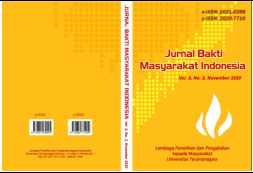EDUKASI PENCEGAHAN PENYAKIT PARU PADA ANAK JALANAN DAN MARJINAL KOMUNITAS SAHABAT ANAK GROGOL JAKARTA BARAT
Main Article Content
Abstract
Lung and respiratory disease are a condition that generates the largest burden of disability-adjusted life-years (DALYs) and most common in the world. The top estimated 10 causes of death worldwide are in 2040, three of them are due to lower respiratory tract infections, chronic obstructive pulmonary disease and lung cancer, which are members of "The Big Five". Common risk factors for respiratory disease are active and passive smoking, pollutants, densely populated areas with low socioeconomic conditions. So, the most vulnerable to exposure are street and marginalized children. In Sahabat Anak Community, which serves street and marginalized children, many children who suffer from acute respiratory infection or cough and colds that aren’t getting better, some even have tuberculosis and shortness of breath. That is because they don’t understand and care about the situation. Therefore, the easiest solution is providing health education and examples directly to prevent disease transmission. Participants were 100 children who assisted by Sahabat Anak Grogol, aged 4-19 years, but only 77 children from grade 4 elementary school filled the questionnaire. The results of the pre-test and post-test to determine the level of knowledge and understanding obtained an average increase from 28.57% to 71.43%. Pollutants on the road (vehicle fumes, dust, cigarette smoke, etc.) are the main risk factors for COPD in street children. Increased understanding and knowledge can change behaviour so the incidence of non-communicable and non-communicable lung and airway diseases in Sahabat Anak Community can reduced and ultimately will improve their quality of life
ABSTRAK:
Penyakit paru dan saluran napas merupakan keadaan yang menghasilkan beban disability-adjusted life-years (DALYs) terbesar dan paling sering terjadi di dunia. Estimasi 10 terbanyak penyebab kematian di seluruh dunia pada tahun 2040, tiga diantaranya diakibatkan berturut-turut oleh infeksi saluran napas bawah, penyakit paru obstruksi kronik dan kanker paru yang merupakan anggota “The Big Five”. Faktor risiko umum dari penyakit paru dan saluran napas tersebut yaitu perokok aktif maupun pasif, polutan, wilayah padat penduduk dengan sosioekonomi rendah sehingga yang paling rentan terpapar adalah anak jalanan dan marginal. Di Komunitas Sahabat Anak yang melayani anak-anak jalanan dan marjinal masih banyak yang menderita ISPA (infeksi saluran napas akut)/batuk pilek tidak sembuh-sembuh, beberapa bahkan TBC dan sesak napas. Hal tersebut karena mereka tidak paham dan tidak peduli mengenai keadaan tersebut. Oleh karena itu, maka solusi yang paling mudah dilakukan adalah memberikan penyuluhan dan contoh langsung cara pencegahan penularan penyakit. Peserta kegiatan adalah 100 anak binaan Sahabat Anak Grogol dengan rentang usia 4-19 tahun, tetapi pengisian kuesioner hanya dilakukan oleh 77 anak dari kelas 4 SD ke atas. Hasil pre-test dan post-test untuk mengetahui tingkat pengetahuan dan pemahaman didapatkan rerata peningkatan 28,57% menjadi 71,43%. Polutan di jalan (asap kendaraan, debu, asap rokok, dan lain-lain) menjadi faktor risiko utama terjadinya PPOK pada anak jalanan. Peningkatan pemahaman dan pengetahuan dapat merubah perilaku sehingga menurunkan angka kejadian penyakit paru dan saluran napas tidak menular serta tidak menular di Komunitas Sahabat Anak dan akhirnya meningkatkan kualitas hidup mereka.
Article Details
This work is licensed under a Jurnal Bakti Masyarakat Indonesia https://creativecommons.org/licenses/by-nc-sa/4.0/
References
CDC. (2018). What Are the Risk Factors for Lung Cancer?. Available from: https://www.cdc.gov/cancer/lung/basic_info/risk_factors.htm
European Respiratory Society. (2013). Respiratory diseases in the world: Realities of Today, Opportunities for Tomorrow. Available from: https://www.ersnet.org/pdf/publications/firs-world-report.pdf
Institute for Health Metrics and Evaluation (IHME). (2018). Findings from the Global Burden of Disease Study 2017. Available from:http://www.healthdata.org/sites/default/files/files/policy_report/2019/GBD_2017_Booklet.pdf
IQAir. (2019). Air quality and pollution city ranking. Available from: https://www.airvisual.com/world-air-quality-ranking
Kemenkes RI. (2019a). Data dan Informasi Profil Kesehatan Indonesia 2018. Diakses dari: http://www.depkes.go.id/resources/download/pusdatin/profil-kesehatan-indonesia/Data-dan-Informasi_Profil-Kesehatan-Indonesia-2018.pdf
Kemenkes RI. (2019b). Hasil Utama Riskesdas 2018. Diakses dari: http://www.depkes.go.id/resources/download/info-terkini/materi_rakorpop_2018/Hasil%20Riskesdas%202018.pdf
Mayo Clinic. (2017). COPD. Available from: https://www.mayoclinic.org/diseases-conditions/copd/symptoms-causes/syc-20353679
Quaderi, S.A., Hurst, J.R. (2018). The unmet global burden of COPD. Glob Health Epidemiol Genom., 3(4). Available from: https://www.ncbi.nlm.nih.gov/pmc/articles/PMC5921960/pdf/S2054420018000015a.pdf
Robinson, J. (2018). Lung disease overview. Available from: https://www.webmd.com/lung/lung-diseases-overview#1
Sahabat Anak. (n.d.). Diakses dari: https://sahabatanak.org/
Terzikhan, N., Verhamme, K.M., Hofman, A., Stricker, B.H., Brusselle, G.G., Lahousse, L. (2016). Prevalence and incidence of COPD in smokers and non-smokers: the Rotterdam Study. Eur J Epidemiol., 31(8):785-792.
WHO. (2007). Global surveillance, prevention and control of Chronic Respiratory Diseases: A comprehensive approach. Available from: https://www.who.int/gard/publications/GARD%20Book%202007.pdf
WHO. (2018). Global Tuberculosis Report 2018. Available from: https://www.who.int/tb/publications/global_report/en/
Yustikarini,K., Sidhartani, M. (2015). Faktor Risiko Sakit Tuberkulosis pada Anak yang Terinfeksi Mycobacterium Tuberculosis.Sari Pediatri, 7(2), 136-140.


